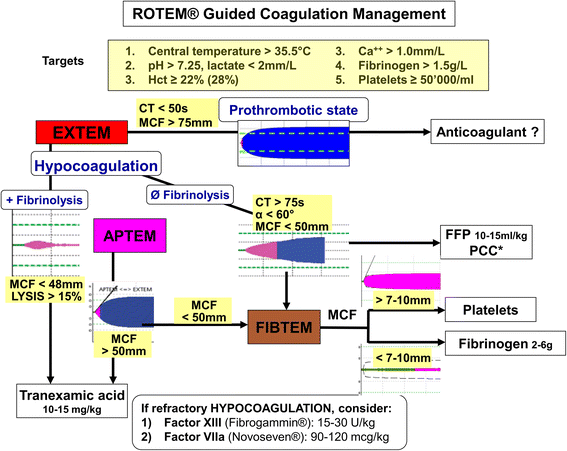Assessment of Haemostasis in patients undergoing emergent neurosurgery by rotational Elastometry and standard coagulation tests: a prospective observational study
- PMID: 29065860
- PMCID: PMC5655946
- DOI: 10.1186/s12871-017-0440-1
Assessment of Haemostasis in patients undergoing emergent neurosurgery by rotational Elastometry and standard coagulation tests: a prospective observational study
Abstract
Background: Rotational elastometry (ROTEM) has been shown useful to monitor coagulation in trauma patients and in major elective surgery. In this study, we aimed to evaluate the utility of ROTEM to identify hemostatic disturbances and to predict the need for transfusion, compared with standard coagulation tests (SCTs) in patients undergoing emergent neurosurgery.
Methods: Over a four-year period, adult patients who met criteria for emergent neurosurgery lasting more than 90 min were included in the study. Blood was collected preoperatively and analyzed with SCTs (international normalized ratio [INR], fibrinogen concentration, prothrombin time [PT or Quick], partial thromboplastine time [PTT], fibrinogen concentration and platelet count), and ROTEM assays. Correlations between SCTs and ROTEM parameters as well as receiver operating characteristic curves were performed to detect a coagulopathic pattern based on standard criteria and the need for transfusing at least 3 units of packed red blood cells (PRBCs).
Results: In a cohort of 92 patients, 39 (42%) required ≥3 PRBCs and a coagulopathic pattern was identified in 32 patients based on SCTs and in 19 based on ROTEM. There was a strong correlation between PTT and INTEM coagulation time (R = 0.76) as well as between fibrinogen concentrations and FIBTEM maximal clot firmess (R = 0.70). The need for transfusion (≥ 3 PRBCs) was best predicted by the maximal clot firmess of EXTEM and FIBTEM (AUC of 0.72 and 0.71, respectively) and by fibrinogen concentration (AUC of 0.70).
Conclusions: In patients undergoing emergent neurosurgery, ROTEM analysis provides valid markers of early coagulopathy and predictors of blood transfusion requirements.
Keywords: Anesthesia; Bleeding; Brain injury; Transfusion; Trauma.
Conflict of interest statement
Ethics approval and consent to participate
This study was approved by the Ethics Committee of the University Hospital of Geneva (Registration N° CER 10–128), with a waiver for informed consent given the emergency context and the fact that ROTEM testing was routinely performed in all surgical patients at high risk of bleeding.
Consent for publication
Not applicable. No individual patient data are reported.
Competing interests
The authors declare that they have no competing interests.
Publisher’s Note
Springer Nature remains neutral with regard to jurisdictional claims in published maps and institutional affiliations.
Figures



References
-
- Epstein DS, Mitra B, Cameron PA, Fitzgerald M, Rosenfeld JV. Acute traumatic coagulopathy in the setting of isolated traumatic brain injury: definition, incidence and outcomes. Br J Neurosurg. 2014:1–5. - PubMed
Publication types
MeSH terms
LinkOut - more resources
Full Text Sources
Other Literature Sources
Miscellaneous

